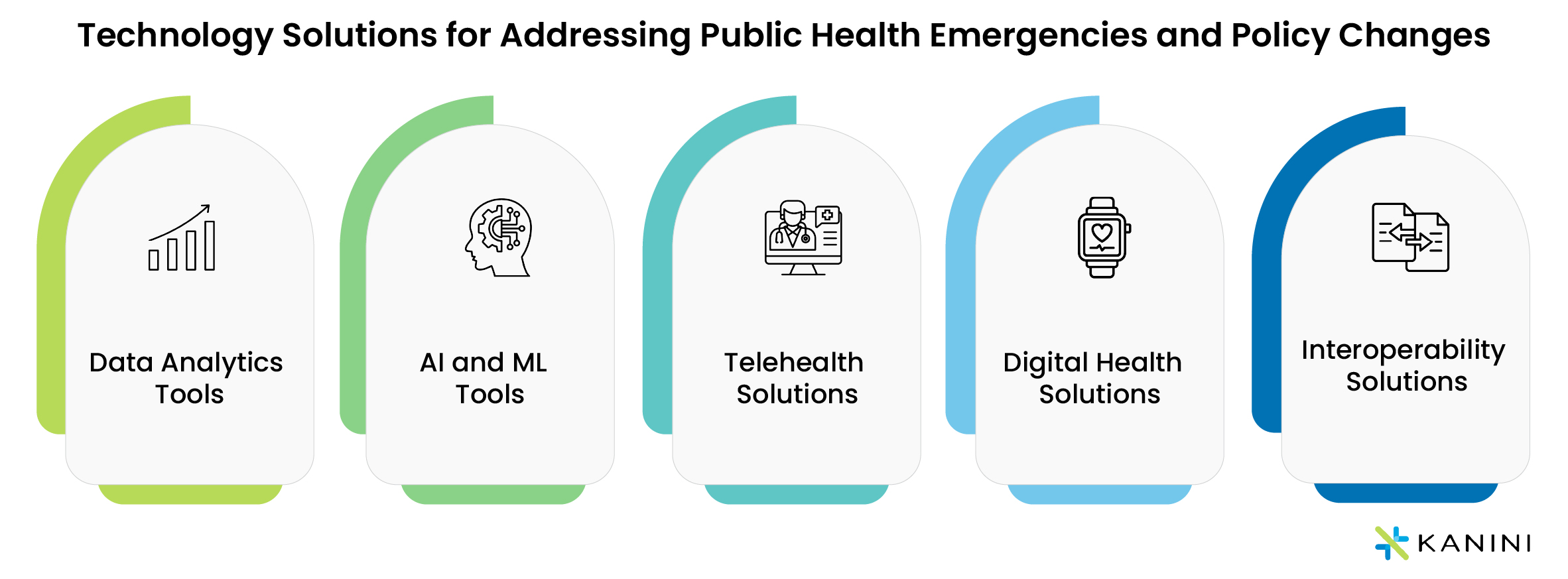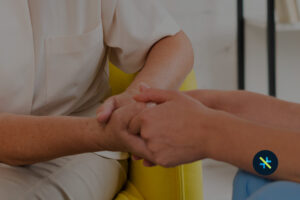Global biological disasters such as pandemics, epidemics, and similar outbreaks have been threatening humans time and again, and over the years we are learning new ways of fighting and managing such unexpected healthcare situations. The outbreak of the COVID-19 virus is one of the most recent examples of such calamities which has been an eye-opener for the world on many fronts, particularly the role of modern technologies in addressing public health emergencies of this magnitude.
During the COVID situation, when the world was struggling to manage the spread of the virus, technology emerged as a powerful tool—supporting healthcare professionals to deal with this contagious disease through remote care delivery, enabling policymakers to drive critical decisions overnight to mitigate the crisis, and empowering the population at large to take concrete steps to contain the spread of the virus through increased awareness.
In our blog post – Preparing for the End of COVID-19 Public Health Emergency (PHE): The Journey Ahead for Care Providers and Payers, we touched upon how providers and payers can easily adapt to the changes in the flexibilities and waivers that are just around the corner by leveraging modern technologies. In this article, we have discussed this in more detail, throwing light on the various new-age technologies that empower payers and providers to sustain the volatilities of healthcare post-pandemic and enable them to adapt to any kind of policy changes and embrace new regulations more seamlessly.
Global Catastrophic Biological Risk (GCBR) Areas Where Modern Technologies Can Make a Difference
A report prepared by Johns Hopkins Bloomberg School of Public Health has shed light on the GCBR areas where technology can be leveraged to derive positive health outcomes.
- Disease Detection, Surveillance, and Situational Awareness Tools
- Infectious Disease Detection that includes Microfluidic Chips, Hand-held Mass Spectrometry, and Cell-free Diagnostics
- Taking precautions against the pathogens that are decentralized, enables the production of drugs and medical supplies across different regions
- Management of medical countermeasures that involve the organization of vaccination campaigns to facilitate and drive large mass vaccination campaigns
- For medical care, robots for surgeries and telehealth (or e-health) technologies make medical interventions possible even in non-traditional, home-like environments.
An Overview of Tech Solutions for Healthcare
The rapid adoption of technology in healthcare is evident from the increasing number of healthcare apps that are being used by people worldwide, how telehealth has become the new normal for care delivery by physicians, and the way in which healthcare organizations are embracing automated EHR systems realizing the importance of centralizing healthcare data. Technology is undoubtedly strengthening the healthcare system in more ways than one. Let’s take a closer look at what are the various technologies that are empowering providers, payers, and patients to quickly adapt to the shifting healthcare landscape post-pandemic and stay prepared for any unforeseen healthcare crisis in the future.


• Data Analytics Tools
During the COVID-19 pandemic, advanced data analytics tools proved to be a boon for administrations to track the spread of the virus, identify hotspots, and monitor and measure the impact of various healthcare strategies and interventions that were being implemented.
To ensure that the healthcare system can sustain any similar crisis more efficiently in the future, the adoption of new-age analytics tools that can analyze large amounts of healthcare data is essential to deliver meaningful insights that enable healthcare providers, payers, and the overall system to improve patient outcomes. These tools can help healthcare professionals analyze patient behavior, predict health risks, forecast demand for care services by tracking healthcare utilization patterns and population health trends through interactive data visualization dashboards, improve processes by identifying gaps and deliver better quality of care.
• AI and ML Tools
AI (artificial intelligence) and ML (machine learning) tools are revolutionizing healthcare, enabling healthcare professionals to better understand and predict patient behavior, offer more personalized care plans, identify patients who are at risk for certain health conditions, make more informed decisions, and deliver positive health outcomes.
Clinical decision support tools driven by AI are assisting healthcare professionals in diagnosing ailments more accurately and promptly to offer timely treatment, take preventive measures, and alleviate the burden on the healthcare system by avoiding unnecessary treatments and taking the right medical decisions.
• Telehealth Solutions
Telehealth is a boon in situations where there is a high risk of exposure to a contagious virus or in cases where the patient is in a remote region and needs urgent medical attention or in complicated medical cases where physicians across locations must collaborate to take certain critical medical decisions. Owing to the numerous benefits of telehealth, it is likely to continue even after the PHE expires, facilitating virtual care delivery, telemedicine consultations, remote patient monitoring, and patient engagement.
• Digital Health Solutions
Digital health solutions, that include wearables, mobile apps for tracking health metrics, digital health coaching, and remote patient monitoring, enhance patient-provider engagement beyond traditional healthcare settings. In situations such as the pandemic when accessing a healthcare facility becomes a challenge, digital health solutions can help individuals take preventive steps, manage their symptoms more proactively, and focus on self-care.
• Interoperability Solutions
Data sharing is the key to transforming the quality of care. Interoperability is crucial for healthcare providers and payers to share data across different systems and drive informed decision-making. Modern EHR/EMR systems powered by technology allow data to be exchanged securely and efficiently across different systems and platforms. This is vital in enhancing care delivery.
A Case in Point: How Technology Helped India Fight the Pandemic and its Aftermath
India’s digital-first trajectory saw a steep rise and recorded one of the highest volumes of digital transactions in the world during the pandemic, further propelling the use of contactless digital technology across India.
According to the Economic Survey 2022-23, the Jan Dhan-Aadhaar-Mobile (JAM) campaign trinity enabled India to develop its first robust, digital COVID-19 vaccination infrastructure ‘Co-WIN’ within a record timeframe and CO-WIN went on to be a lifesaving endeavor for the nation.
To throw more light on CO-WIN, it was developed as an extension of the eVIN (electronic Vaccine Intelligence Network) platform. Ever since its launch, the comprehensive cloud-based IT solution has been instrumental in planning, implementing, monitoring, and evaluating COVID-19 vaccination in India. And it continues to offer an end-to-end solution with utilities for the entire Indian public health system. The present administration of more than 2.2 Bn COVID-19 vaccine doses as a part of the National COVID-19 Vaccination Program has been made possible through the CO-WIN app.
In addition to CO-WIN, to manage the COVID-19 crisis, the state-central governments and even local civic bodies in India turned to several other digital health solutions, embracing close to 15 new applications to control the spread, track quarantined individuals, share the latest health updates, get feedback, map affected citizens, and geofence places with many infections, that garnered an estimated userbase of around 10 million within a short span of time. ‘Arogya Setu’ emerged as one of the most used COVID-19 apps among Indians.
This readiness for technology solutions and digital platforms during the pandemic came as a business opportunity for many start-ups to introduce their tech offerings that could alleviate the crisis in India. In fact, the second wave of COVID-19 turned out to be a second wave of innovation for India, where digital solutions enabled the population to overcome the challenges of acute shortage of hospital beds, ventilators, oxygen supplies, etc. by connecting them to locations across the country where these emergency medical supplies were readily available.
Summing up, it’s remarkable how without declaring a Public Health Emergency, a country of 1.3 billion with limited healthcare resources managed this crisis so well and even surpassed many developed nations with timely adoption of modern technologies.
A Strategic Approach to Embracing Technology and Thriving in This Rapidly Changing Healthcare Landscape
With unprecedented challenges brought in by the COVID-19 pandemic, it is very evident that technology adoption is the key to sustaining the volatility in today’s healthcare landscape. Having said that, the healthcare IT market is huge and healthcare organizations can leverage numerous modern digital tools and solutions out there and achieve positive patient outcomes. This often leaves providers and payers wondering what technology is right for them and where to start.
The journey of digital transformation begins with a strong commitment and a positive, forward-looking approach to adapt to the changes. The first step thereafter is to identify and implement the right solutions that meet their specific needs and can be seamlessly integrated into their existing systems. However, it is also here that healthcare organizations often fumble. A well-thought-out technology roadmap with a strategic approach is what providers and payers need to identify the most appropriate technology solutions.
Today, most healthcare organizations are seeking guidance from IT consulting experts who bring in board industry-specific experience and knowledge. This way, they can ensure that the digital transformation is more holistic and sustainable and make technology adoption far more rewarding. The expert assistance helps healthcare providers and payers stay aligned to the latest industry trends and emerging technologies, strengthen their data management capabilities, support data analysis for informed decision-making, and gain a competitive advantage over time. The adoption of the right technology, for the right purpose, at the right time, translates into improved patient outcomes and experience and enhanced cost-savings through upgraded process efficiencies. It makes adhering to frequent policy changes much easier, without compromising on the quality of care.
KANINI’s expertise in Cloud Computing, Agile Product Engineering, Data Analytics & AI, Automation, IoT, and custom solutions has enabled providers, payers, intermediaries, and other stakeholders in the healthcare delivery chain to solve their business challenges while maintaining a patient-centric approach. If you are looking for more information on what are the various technology solutions and data tools that can be leveraged to meet your specific requirements and challenges, reach out to us.
Author

Neha Sinha
Neha is leading the business consulting efforts for the Healthcare BU at KANINI. She brings on board 15+ years of experience in driving various critical functions such as Business Analysis, Presales, Client Relationships, and Domain Consulting. Neha has spent over a decade working with healthcare clients and engagements in the US market.








